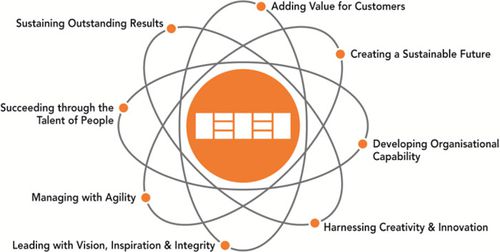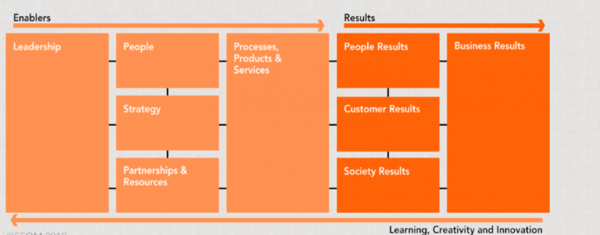EFQM Excellence Model
The EFQM Excellence Model is a non-prescriptive business excellence framework for organizational management systems, promoted by EFQM (formerly known as the European Foundation for Quality Management) and designed for helping organizations in their drive towards being more competitive. The Model is regularly reviewed and refined. Regardless of sector, size, structure or maturity, organizations need to establish appropriate management systems in order to be successful. The EFQM Excellence Model is a practical tool to help organizations do this by measuring where they are on the path to excellence; helping them understand the gaps; and then stimulating solutions.[1]
Fundamental Concepts (Basic Principles) of EFQM Excellence Model[2]
There are eight Fundamental Concepts of Excellence. They are the underlying principles for any organization to achieve sustainable excellence and develop an excellent organizational culture:
1. Adding value for customers: Excellent organizations consistently add value for customers by understanding, anticipating and fulfilling needs, expectations and opportunities.
2. Creating a sustainable future: Excellent organizations have a positive impact on the world around them by enhancing their performance whilst simultaneously advancing the economic, environmental and social conditions within the communities they touch.
3. Developing organizational capability: Excellent organizations enhance their capabilities by effectively managing change within and beyond the organizational boundaries.
4. Harnessing creativity and innovation: Excellent organizations generate increased value and levels of performance through continual improvement and systematic innovation by harnessing the creativity of their stakeholders.
5. Leading with vision, inspiration and integrity: Excellent organizations have leaders who shape the future and make it happen, acting as role models for its values and ethics.
6. Managing with agility: Excellent organizations are widely recognized for their ability to identify and respond effectively and efficiently to opportunities and threats.
7. Succeeding through the talent of people: Excellent organizations value their people and create a culture of empowerment for the achievement of both organizational and personal goals.
8. Sustaining outstanding results: Excellent organizations achieve sustained outstanding results that meet both the short and long-term needs of all their stakeholders, within the context of their operating environment.

source:BQF
Benefits and Limitations of EFQM Excellence Model[3]
Benefits
- The Excellence Model provides a holistic framework that systematically addresses a thorough range of organizational quality issues and also gives attention to impacts through the ‘results’ criteria.
- It provides a clear diagnosis of an organization’s activities and is useful for planning as it makes links between what an organization does and the results it achieves, highlighting how they are achieved.
- It seeks to instil a culture of continuous improvement.
- It is flexible enough to be used in bite-sized chunks or for specific issues – e.g., an analysis of an organization’s environmental policy in less than a single day as well as providing a framework for a comprehensive review of all the organization’s activities over several months.
- There is no requirement for external validation and the Excellence Model can be used as an internally driven self-assessment tool allowing an organization to be as honest and as open as possible in gauging its performance.
- Scoring’ can provide an organization with an internal benchmark for its next self assessment, in order to capture trends. It can also be used among organizations for some external benchmarking and comparison.
- The Excellence Model stresses the importance of consensus in assessing an organization’s strengths and areas to improve.
Limitations
- Although there is an option for ‘scoring’ and an Awards Recognition scheme, they may be expensive for smaller social enterprises to enter.
- There is no formal mark or accreditation for the Model and it will not be overtly visible or recognizable to customers, service users, funders and other stakeholders. However EFQM does offer awards to organizations, showcasing winners through its website and networks.
- Though it has been used successfully by a number of medium and large voluntary organizations, it was initially developed for the commercial sector and some of the language of the Excellence Model may not translate easily to social enterprises or voluntary organizations. There are limited examples of use by third sector organizations.
EFQM Excellence Model Criteria[4]
The EFQM Excellence Model is based on nine criteria. Five of these are "Enablers" and four are "Results". The "Enabler" criteria cover what an organization does and how it does it. The "Results" criteria cover what an organization achieves.
To achieve sustained success, an organization needs strong leadership and clear strategic direction. They need to develop and improve their people, partnerships and processes to deliver value-adding products and services to their customers. In the EFQM Excellence Model, these are called the Enablers. If the right Enablers are effectively implemented, an organization will achieve the Results they, and their stakeholders, expect.

source: efqm.org
The arrows emphasize the dynamic nature of the Model, showing learning, creativity and innovation helping to improve the Enablers that in turn lead to improved Results. Each of the nine criteria has a definition, which explains the high level meaning of that criterion. To develop the high level meaning further each criterion is supported by a number of criterion parts. Criterion parts are statements that describe in further examples of what, typically, can be seen in excellent organizations and should be considered in the course of an assessment. Finally, below each criterion part are guidance points. Many of these guidance points are directly linked to the Fundamental Concepts. Use of these guidance points is not mandatory. They are intended to give examples to aid interpretation of the criterion part.
See Also
Baldrige Award
Business Excellence
References
External References
- The ISO Quality Management Principles and the EFQM Model EMC
